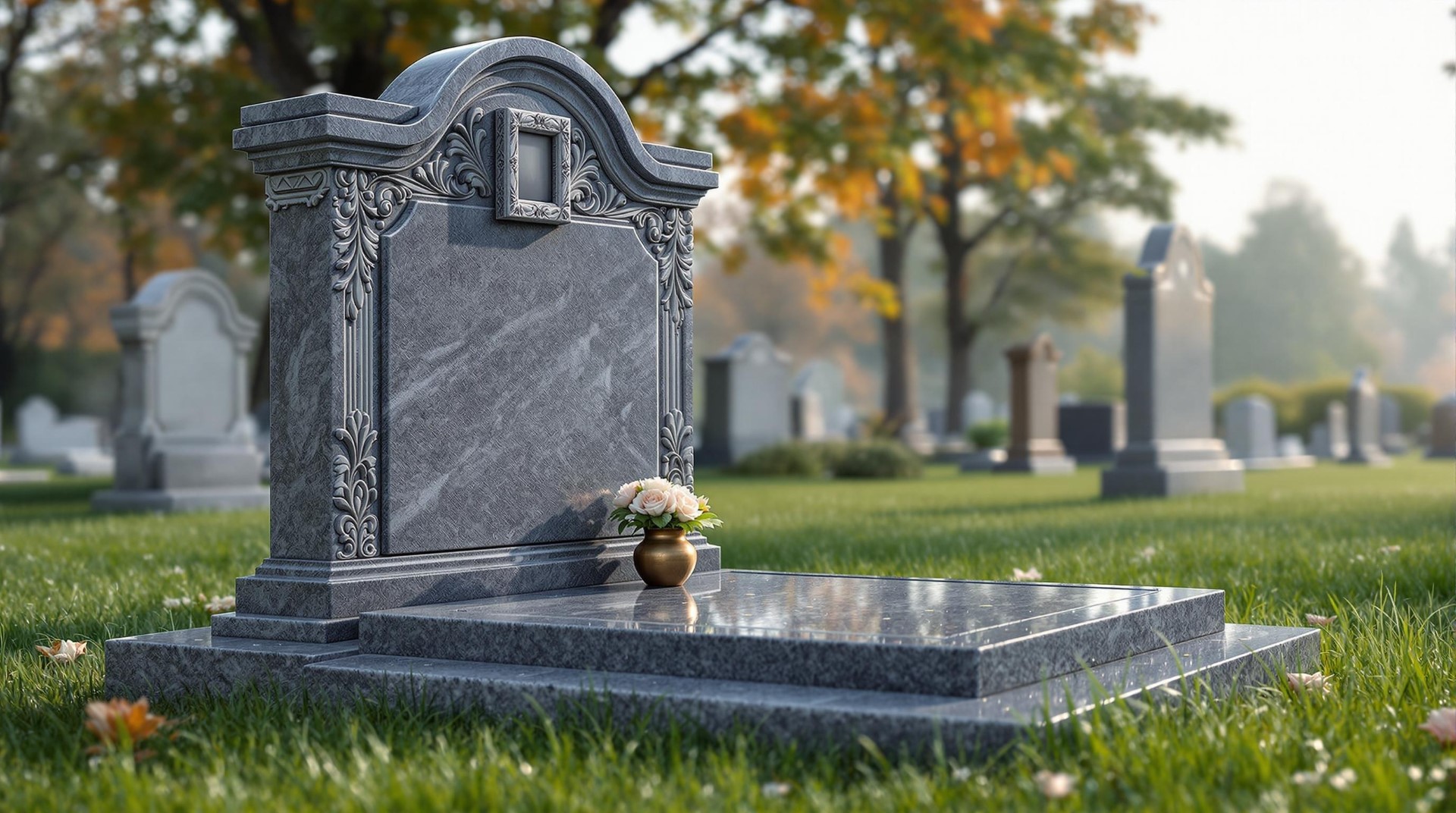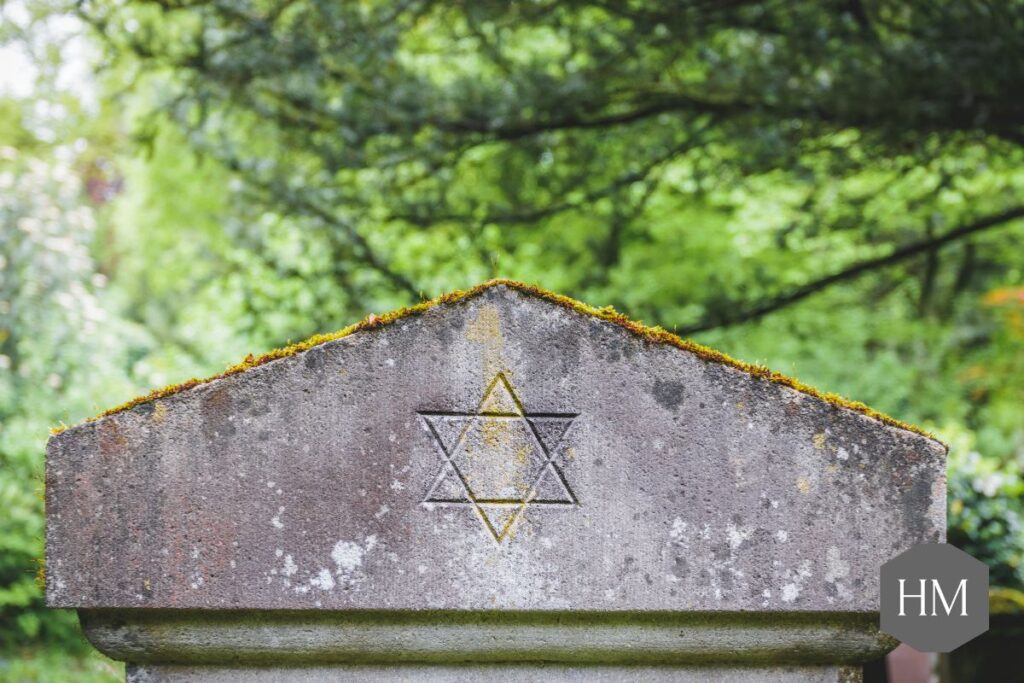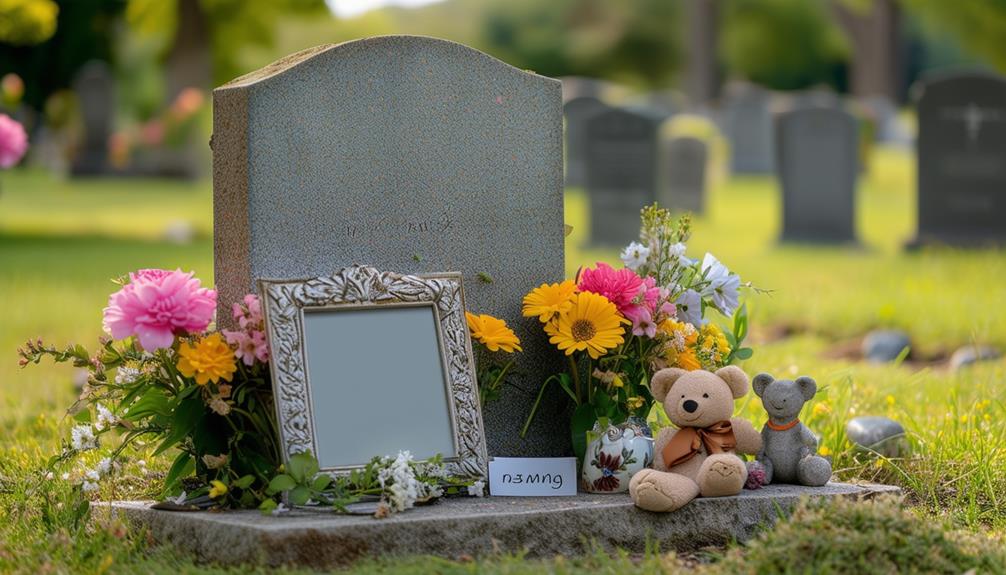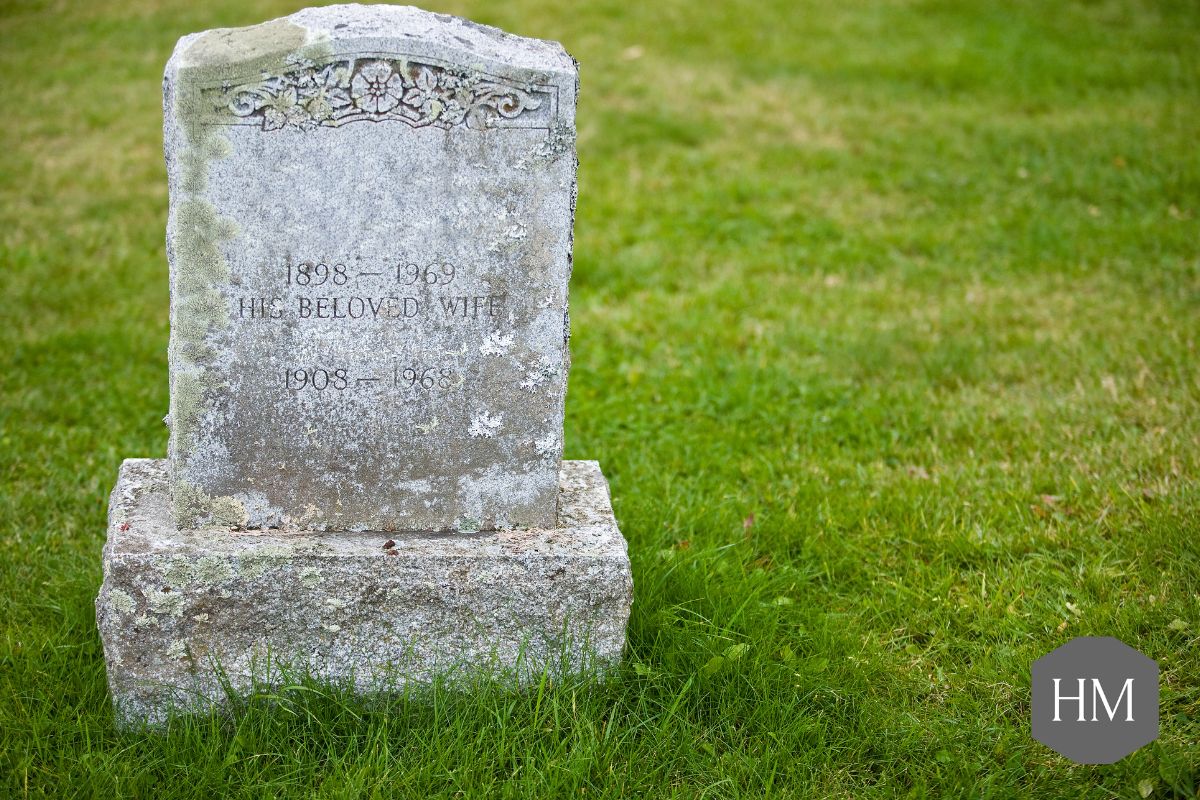When you think about what goes on a headstone, you might first consider the basic information: the name, birth and death dates. But there’s so much more to it than that. An epitaph can capture the essence of a person’s life, while symbols might reflect their passions or beliefs. You may wonder about the choices that resonate most meaningfully and how to balance personal touches with cemetery guidelines. As you explore these elements, you’ll uncover insights that could make a headstone truly special.
At a glance
- Full name, birth and death dates, and age at death are essential details for clear identification and record-keeping.
- Thoughtful epitaphs memorialise the deceased, reflecting their character and providing comfort to loved ones.
- Religious symbols can represent the deceased’s faith and beliefs, enhancing the meaning of the memorial.
- Personal touches, such as hobbies and quotes, create a unique tribute that celebrates the individual’s life.
- Compliance with cemetery regulations ensures proper headstone placement and maintains a respectful appearance within the cemetery.
Basic Information

When creating a headstone inscription, you’ll want to include essential details like the deceased’s full name, dates of birth and death, and age at death.
Additionally, consider adding a heartfelt inscription that reflects their personality or values, as this can provide comfort to those who visit the grave.
This information not only honours their memory but also provides a clear record for future generations.
By ensuring these basics are accurately represented, you create a meaningful tribute that captures their life story.
For inspiration, you might explore heartfelt inscriptions that honour both parents or other loved ones.
Full Name
Typically, the full name of the deceased takes center stage on a headstone, ensuring their identity is unmistakably recognised. This headstone inscription is essential for honouring their memory in a respectful and lasting way.
When selecting the full name for engraving, consider the following:
- Include the Middle Name or Initial: Adding a middle name or initial can personalise the inscription and help distinguish them from others with similar names. Customisation options for size and design can also enhance the memorial’s significance, as seen in our extensive collection of memorial headstones.
- Use Larger Font: Names are often displayed in a larger font, emphasising their importance and making them easy to read during visits.
- Honour Family Lineage: In some cultures, it’s customary to include a maiden name for females, honouring their family lineage and providing a fuller picture of their identity.
Before finalising the full name for the headstone, double-check the spelling for accuracy. Errors can be costly and emotionally challenging to correct later. By ensuring the full name is accurately represented, you create a lasting tribute that honours their loving memory, providing comfort for those who visit during their burial.
Dates of Birth and Death
Including the dates of birth and death on a headstone marks the passage of a person’s life and serves as a clear record of their time on earth. These dates are essential components of the gravestone, typically formatted as “Born: [date]” and “Died: [date].” This clear presentation helps visitors understand the lifespan of the individual commemorated by the memorial.
Placement on the gravestone often follows the name, guaranteeing they’re legible for all who visit. Additionally, cultural or religious traditions may influence how these dates are presented. Some communities may use specific formatting or additional symbols that hold significance, enhancing the inscription’s meaning.
Ultimately, the dates of birth and death not only honour the individual but also provide a timeline that connects their legacy to the lives of those who remember them.
Age at Death
The age at death is an essential piece of information on a headstone, offering a clear indication of how long a person lived.
Including this detail can provide a meaningful tribute to your loved one, reflecting not just the years but the life experienced. Typically, the age at death is presented alongside the birth date and death date, often formatted as “Aged XX years” or simply as a number.
Epitaphs may also incorporate the age to encapsulate the essence of a person’s life, providing comfort and resonance to those who visit the grave, often drawing inspiration from various categories of epitaphs that honour and remember loved ones.
Here are three key points to take into account when inscribing the age at death on a headstone:
- Clarity: Make sure the age is easy to read, both regarding font choice and placement on the stone.
- Cultural Significance: Be aware that, in some cultures, the age at death carries profound emotional weight, especially if the individual passed at a young age.
- Design Harmony: Reflect on how the age fits into the overall design of the headstone, making certain it complements other elements like names and dates.
Epitaphs
Epitaphs are brief inscriptions on headstones that honour the deceased, often capturing their essence and relationships.
Choosing the right words can create a lasting tribute that resonates with family and friends, so consider themes like love, remembrance, or personal beliefs.
In this section, you’ll find examples of epitaphs and tips for crafting one that truly reflects your loved one’s unique personality.
Definition and Importance of epitaphs
honouring a loved one with an epitaph can bring comfort and a sense of closure. An epitaph is a brief inscription placed on a headstone or grave marker that serves to memorialise the deceased.
The importance of an epitaph lies in its ability to encapsulate the essence of a person’s life and the sentiments of those who loved them. Here are three reasons why choosing an epitaph is significant:
- Lasting Memorial: Epitaphs provide a permanent reminder of the individual’s impact on those around them, allowing memories to endure.
- Personal Connection: They allow family and friends to express their love and honour the deceased’s relationships, emphasising roles like “beloved mother” or “devoted husband.”
- Meaningful Reflection: Selecting an epitaph requires thoughtful consideration, as it highlights the individual’s character and conveys the sentiment you want to share.
Ultimately, an epitaph on a headstone can be a powerful way to celebrate a life and keep memories alive for future generations.
Examples of Epitaphs
When crafting an epitaph, you can draw inspiration from various themes and sentiments that capture the essence of your loved one. Epitaphs often reflect the individual’s life, relationships, and qualities, making them a meaningful addition to headstones.
You might choose to use commonly used phrases like “Forever loved, forever missed,” which convey deep affection. Alternatively, consider incorporating personal anecdotes that highlight unique aspects of their life, such as a favorite hobby or a cherished memory.
For instance, if your loved one was an avid gardener, an epitaph could read, “In the garden of life, she blossomed.” This not only personalises the inscription but also celebrates their passions.
Additionally, you might include famous quotes that resonate with their values, adding another layer to the memorial.
As you choose the right words, think about the lasting impact they’ll have during future visits. The goal is to create a lasting tribute that evokes fond memories and honours the individual’s legacy.
Tips for Crafting a Unique Epitaph
Crafting a unique epitaph involves thoughtful consideration of the deceased’s personality and the impact they’d on those around them. To create a meaningful tribute that truly reflects their essence, here are some tips you may want to keep in mind when deciding what to put on a headstone:
- Personal Touch: Include a personal quote or saying that resonates with their values or beliefs. This can add depth to the epitaph and make it more relatable.
- Brevity is Key: Keep the epitaph concise. A short, poignant message often enhances emotional impact and guarantees clarity for those visiting the cemetery in the future.
- Collaborative Effort: Involve family and friends in the process. Their insights and shared memories can help you craft an epitaph that truly honours the deceased’s life and relationships.
When you write on a headstone, remember that this is a lasting tribute.
Take your time and choose words that will be cherished by those who come to remember and celebrate the life that was lived.
Religious Symbols and Beliefs

When considering headstone inscriptions, incorporating religious symbols can provide a meaningful reflection of the deceased’s beliefs.
Common symbols like crosses, Stars of David, and crescent moons not only signify faith but also serve as a source of comfort for loved ones.
Importance of Religious Symbols
Religious symbols on headstones play an essential role in honouring the deceased’s faith and values. These symbols provide comfort to family members, while also reflecting the beliefs and traditions that shaped the individual’s life.
When choosing a headstone, it’s important to reflect on how these religious symbols can convey a heartfelt message.
Here are three key reasons why religious symbols matter:
- Representation of Faith: They signify the deceased’s religious beliefs, reminding loved ones of their spiritual journey and connection to a higher power.
- Cultural Significance: Each symbol carries unique theological meanings, such as the cross for Christians, the Star of David for Jews, and the crescent moon and star for Muslims, reinforcing cultural identity.
- Connection for the Bereaved: The presence of these symbols can create a sense of continuity for family members, fostering shared beliefs during memorial visits.
Incorporating religious symbols on headstones can help express the deceased’s values and offer solace to those left behind, ensuring that their faith is remembered and respected.
Common Religious Symbols
Symbols play a significant role in expressing the beliefs and values of the deceased, making headstones more personal and meaningful. When choosing a religious symbol for a headstone, consider the significance it holds for the individual and their faith.
For example, the cross is a powerful emblem in Christianity, representing faith and salvation; it often accompanies verses or prayers that reflect the individual’s spiritual journey.
In Judaism, the Star of David signifies a connection to God and Jewish identity, frequently appearing on Jewish gravestones. For those of the Islamic faith, the crescent moon and star symbolise devotion, and gravestones may also feature Quranic verses to honour the departed.
In Buddhism, the lotus flower symbolises purity and rebirth, often used to represent the cycle of life and enlightenment.
Meanwhile, Hindu headstones may incorporate the Om symbol, reflecting beliefs in reincarnation and the sacredness of life, often accompanied by inscriptions from sacred texts.
Personal Touches

When personalising a headstone, think about incorporating symbols that reflect your loved one’s hobbies and interests, like musical notes or sports equipment.
You might also consider adding a meaningful quote or phrase that captures their spirit and connects with family members.
These personal touches not only celebrate their life but also create a lasting memory for those who visit.
Hobbies and Interests
A headstone can be more than just a marker; it can be a celebration of a person’s life and passions. Including hobbies and interests on a headstone is a meaningful way to add a personal touch, allowing visitors to remember the deceased beyond their life dates.
This can foster a sense of connection among family and friends while honouring unique traits.
Consider incorporating the following elements:
- Symbols of Passion: Engravings of sports symbols, musical notes, or gardening tools can represent cherished hobbies.
- Personal Quotes: Include phrases that reflect the individual’s enthusiasm for their interests, adding depth to the memorial.
- Visual Representations: Images of specific items, such as fishing rods, books, or instruments, invite storytelling during visits and keep memories alive.
These thoughtful engravings not only enhance the headstone’s significance but also create a lasting tribute to the individual’s interests.
Family Connections
Creating a meaningful headstone often involves highlighting family connections to celebrate the bonds that defined a person’s life. When you think about the inscription, consider using descriptors like “Beloved wife,” “Cherished mother,” or “Loving daughter.” These phrases personalize the memorial and instantly convey the relationships that mattered most.
Incorporating personal touches also means including the names of surviving family members. This creates a sense of continuity, reminding visitors of the enduring ties that connect them to the deceased. You might also want to add symbols or motifs that reflect your family heritage, such as religious symbols or cultural icons, which help illustrate the individual’s values.
Additionally, consider including family quotes or shared sayings; these comforting reminders can encapsulate the cherished bonds you shared.
Ultimately, each engraving and symbol enhances the emotional significance of the memorial, ensuring it serves as a lasting tribute to your family’s love and connections.
Additional Considerations
When choosing a headstone, you’ll want to contemplate materials and designs that best reflect your loved one’s personality while also adhering to local regulations.
It’s important to check cemetery guidelines, as these can dictate the size and style of the headstone you select.
Additionally, keeping your budget in mind will help you make informed decisions that honour your loved one without overspending.
Material and Design
While choosing a headstone, selecting the right material and design is essential for creating a lasting tribute. You’ll want a headstone that not only honours your loved one but also withstands the test of time.
Here are some key factors to ponder:
- Material: Granite, marble, and bronze are popular choices due to their durability and resistance to weathering. Granite is particularly favored for its longevity and variety of colours.
- Design: The design of the headstone can reflect the personality of the deceased. You can opt for traditional upright stones, modern flat markers, or even custom shapes that hold special meaning.
- Engraving: Intricate carvings, engravings, or etchings can add a personal touch, showcasing symbols or religious motifs that resonate with the individual’s life.
Keep in mind that cemetery regulations may influence the size and shape of your headstone, so it’s wise to check those guidelines early on.
Local Regulations and Guidelines
Maneuvering local regulations and guidelines is vital when planning a headstone installation. Each cemetery has its own set of rules that dictate the size, shape, and material of headstones, so it’s important to consult with the cemetery administration for specific guidelines.
Many cemeteries impose restrictions on the types of inscriptions and designs that can be used, guaranteeing a cohesive and respectful appearance across the grounds. You may also need permits for headstone installation or modifications, so checking if any fees are associated with these permits is advisable.
Certain cemeteries designate areas for specific types of memorials, such as upright stones versus flat markers.
Adhering to these designations is important for compliance. By understanding and following these local regulations, you can make sure that your headstone reflects your loved one’s memory while respecting the cemetery’s standards. This careful attention to detail will help you create a lasting tribute that fits seamlessly into its surroundings.
Budget Considerations
Understanding local regulations is just the beginning; budget considerations play an important role in planning a headstone. When you start this journey, it’s essential to account for various costs associated with the memorial.
Here are three key elements to keep in mind:
- Material Costs: Granite is a popular choice due to its durability, but prices can vary based on quality and thickness. Research different options to find what fits your budget.
- Custom Engravings and Designs: If you’re considering unique shapes, sizes, or intricate designs, remember that custom engravings can greatly increase the overall expense. Plan for these additional charges to avoid surprises.
- Installation Fees: Don’t forget about installation fees, which can vary depending on the cemetery’s guidelines and the complexity of the placement.
Always check cemetery guidelines beforehand, as they can impact your choices and expenses.
Frequently asked questions
What is appropriate to put on a headstone?
Common elements appropriate for headstones include:
- Full name of the deceased
- Dates of birth and death
- Religious symbols relevant to their faith
- Brief epitaphs or meaningful quotes
- Terms of endearment (Beloved Mother, Loving Husband, etc.)
- Military service information and honors
- Professional titles or achievements
- Family relationships
- Simple decorative elements like flowers or birds
- Bible verses or spiritual references
- Short personal messages
- Nicknames (in addition to legal names)
The chosen elements should:
- Remain legible for years to come
- Respect cemetery regulations
- Reflect the deceased’s personality and beliefs
- Stay within space limitations
- Maintain appropriate dignity
- Be timeless rather than trendy
- Consider cultural and religious traditions
What names go on a headstone?
The names on a headstone typically include:
- Full legal name of the deceased (first name, middle name(s) and surname)
- Maiden name (if applicable)
- Nickname (optional, often in quotation marks)
- Names of other family members buried in the same plot
- Family title (optional, e.g., ‘Beloved Wife of…’ or ‘Mother of…’)
Additional name-related considerations:
- Local cemetery regulations may affect name formatting
- Professional titles may be included (Dr, Rev, etc.)
- Military ranks can be engraved if the deceased served
- Multiple surnames can be shown to reflect name changes
- Names should be checked against official documents for accuracy
What is a good saying to put on a headstone?
Popular and meaningful short headstone sayings include:
- “Forever in our hearts”
- “Until we meet again”
- “Gone but never forgotten”
- “Rest in peace”
- “Always loved, never forgotten”
- “Together forever”
- “In loving memory”
Biblical verses and literary quotes are also common choices:
- “The Lord is my shepherd” (Psalm 23)
- “Amazing grace”
- “Peace, perfect peace”
- “Death leaves a heartache no one can heal, love leaves a memory no one can steal”
Personalised options might include:
- A favourite saying of the deceased
- Lines from a meaningful song or poem
- References to hobbies or passions
- Dates and family relationships
- Professional achievements or contributions
Consider consulting the cemetery’s regulations regarding inscription length and style before making a final choice and also consulting our post with more than 250 epitaphs to use for inspiration.
Conclusion
In summary, creating a meaningful headstone involves careful consideration of essential details like names, dates, and personal touches. By incorporating an epitaph and symbols that reflect your loved one’s values and interests, you can create a lasting tribute.
Remember to adhere to cemetery regulations and choose materials that resonate with your memories. With thoughtful planning, you can guarantee the headstone serves as a fitting remembrance, honouring the life and legacy of the individual it represents.
At Haven Memorials our team are here to guide you through the process of purchasing a headstone for your loved one, get in touch with us today to find out more.
